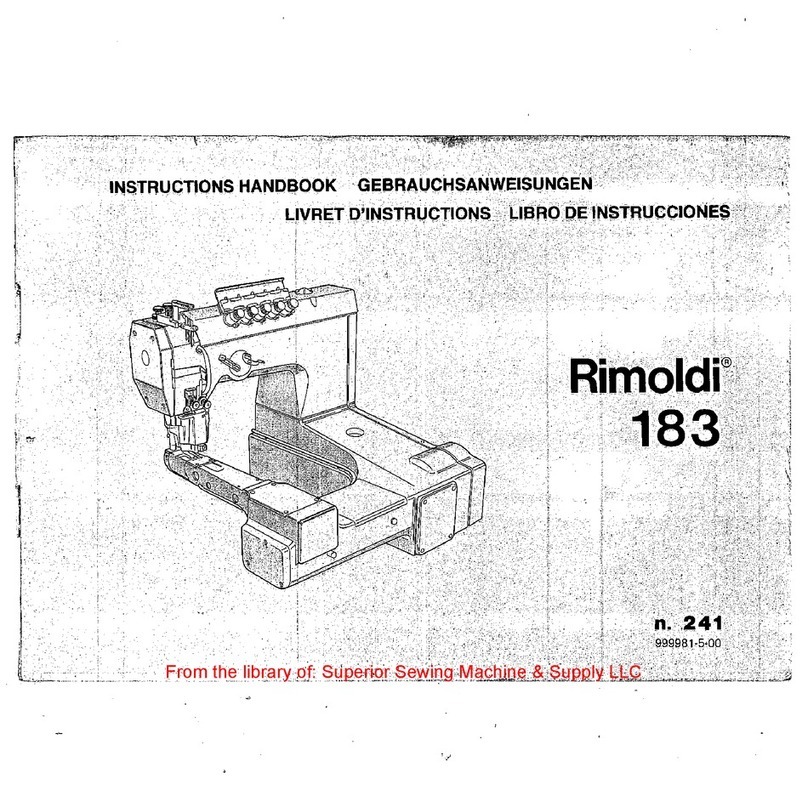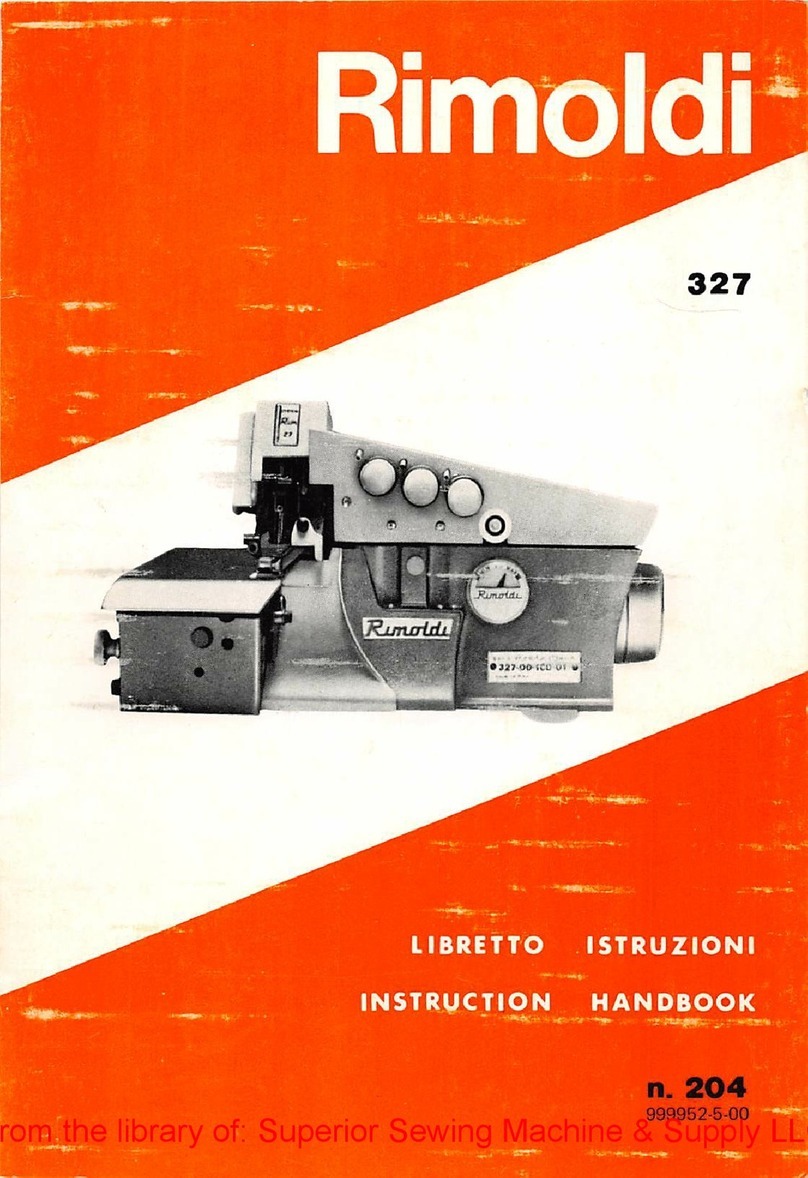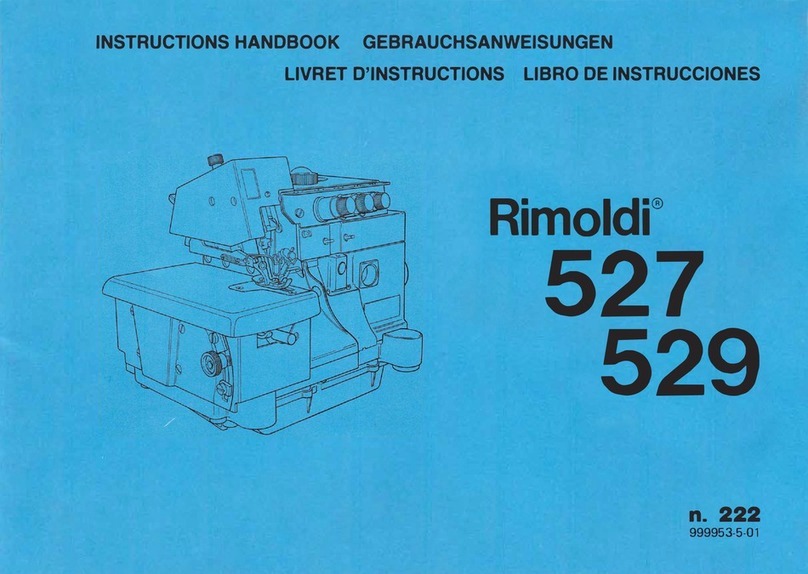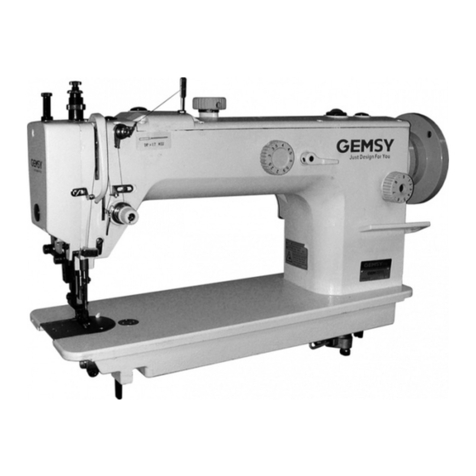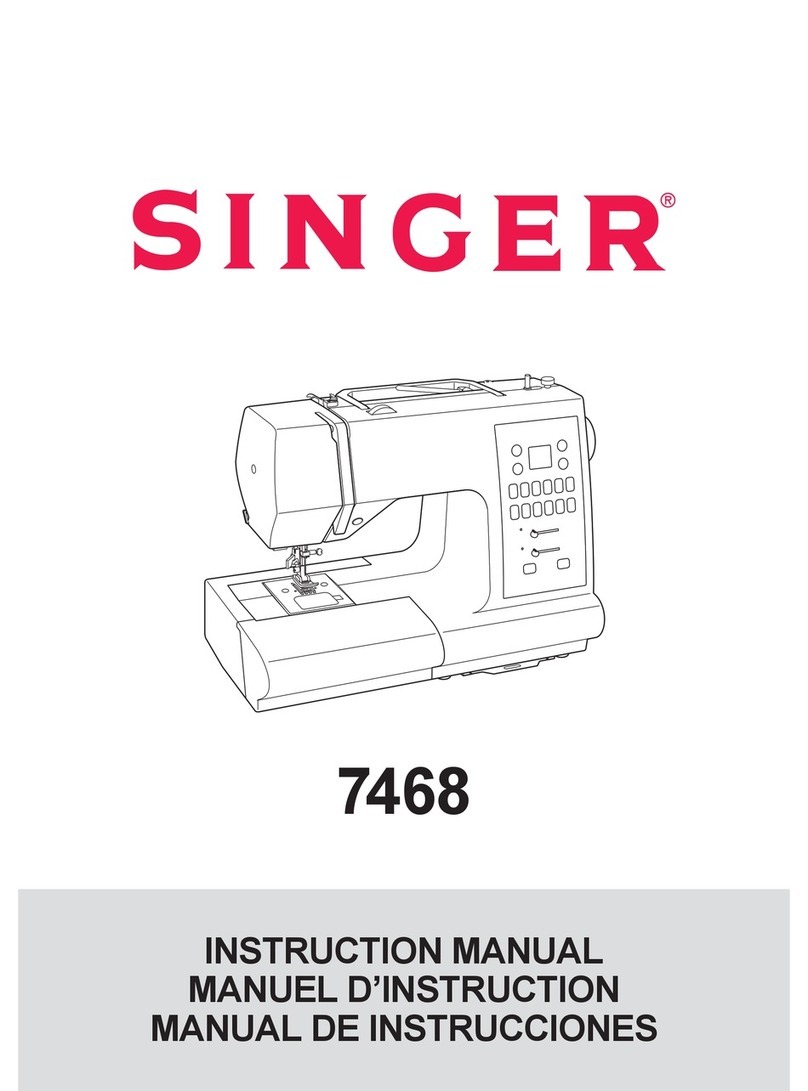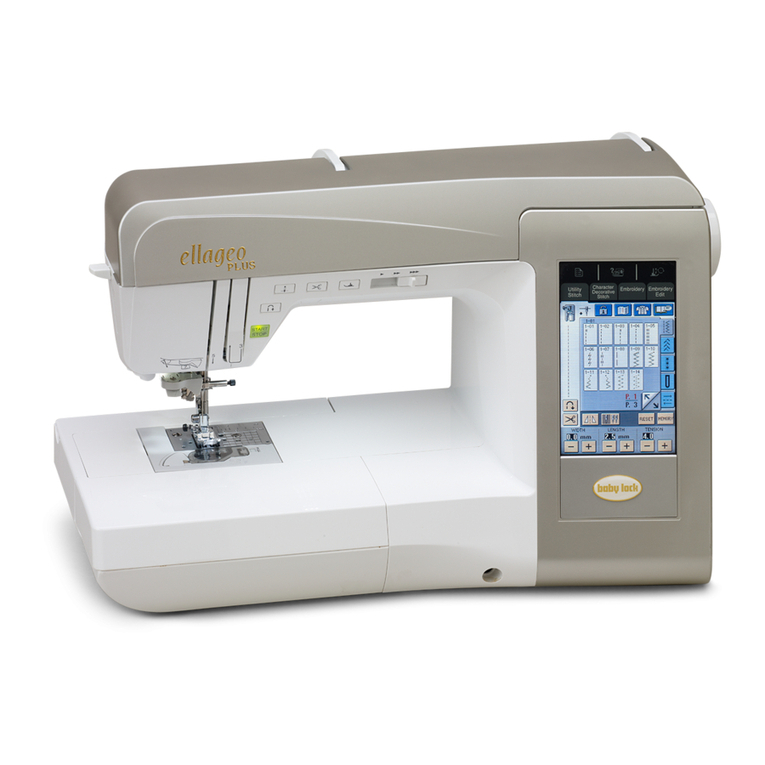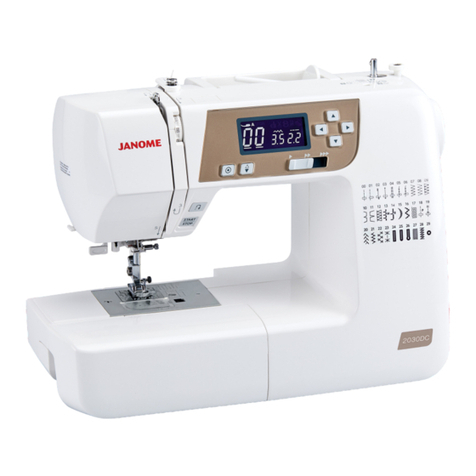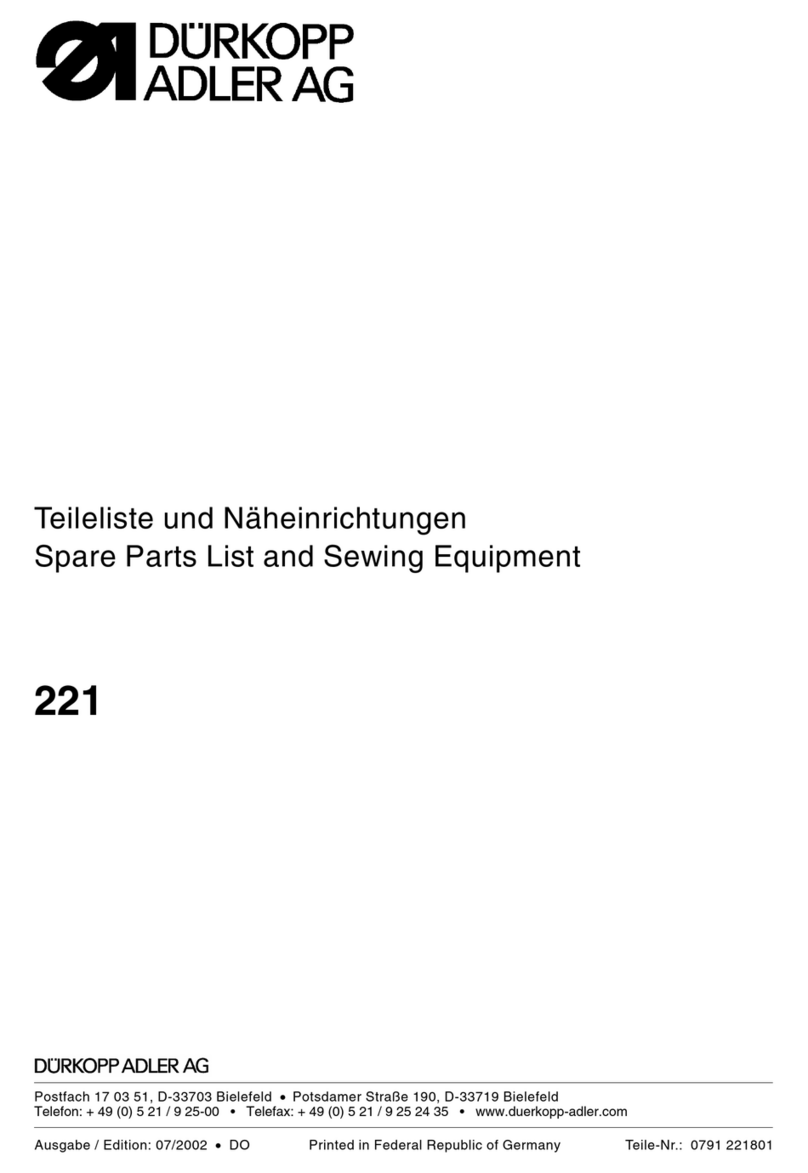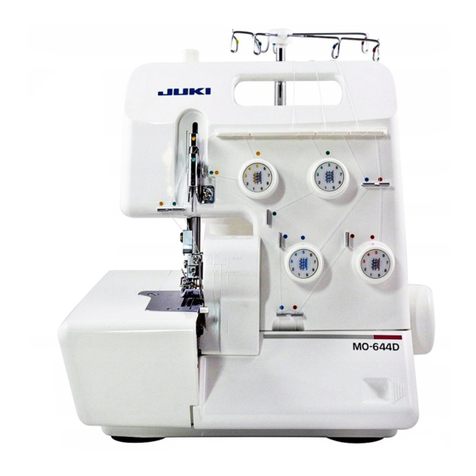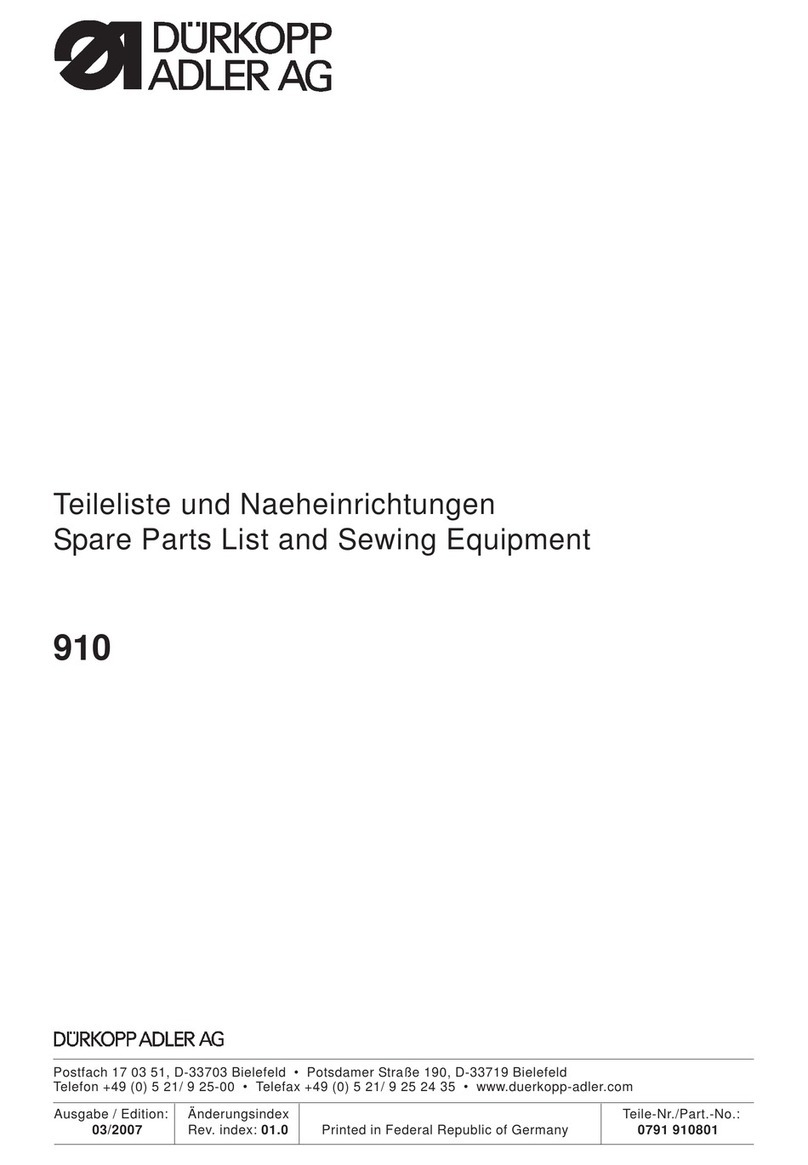Rimoldi 171 manual

Rimoldi
LIBRETTO
ISTRUZIONI
INSTRUCTION
HANDBOOK
From the library of: Superior Sewing Machine & Supply LLC

ATTENZIONE
Prima
di
allacciare
il
motore
alia
rete
di
alimentazlone
occorre:
1) Verlflcare
che
il collegamento della morsettlera interna del motore sla quello
effettivamente richiesto dalla tensione della rete di alimentazione, in
quanto
tutti
i
motori
sono
allacciati
per
la massima
tensione
consentita
dal
motore
stesso.
2) Verificare
che
i fusibili
dell'interruttore
corrispondano, in base alia
potenza
del
motore
ed alia sua effettiva
tensione
di
alimentazione
al valore in
Ampere
riportato
nella
sottoindicata
tabella.
3) Serrare a
fondo
i
tappi
porta
fusibili onde assicurare un
perfetto
contatto
elettrico.
PROSPETTO
PER
LASCELTA
DEI
FUSIBILI
FUSIBILI
POTENZA
MOTORI
TRIFASE
POTENZA
MOTORI
MONOFASE
SIMBOLI
A
1/3
HP
1/2
HP
3/4
HP
1/3
HP
1/2
HP
3/4
HP
420
380
910330-0-00
280
6
260
420
•>
240
420
380
UJ
220
380
420
280
420
z
o
160
280
380
N
<
910331-0-00
10
125
260
280
260
380
1-
z
110
240
260
240
280
UJ
s
220
240
220
260
420
-J
160
160
240
380
o
910332-0-00
15
125
220
125
220
280
UJ
2
110
160
110
160
260
O
(0
z
UJ
K
125
125
240
910333-0-00
20
110
110
220
160
910334-0-00
25
125
110
From the library of: Superior Sewing Machine & Supply LLC

ATTENTION
Before connecting
motor
to mains supply:
1)
Check
that
the
connection
of
the
terminal
board
inside
the
motor
are
suited
to
the
current
supply
available,
bearing
in
mind
that
all
motors
are
connected
for
the
higher of
the
possible
motor
voltages.
2) Check
that
switch fuses correspond —according to power of
motor
and its
effective
feed voltage —
to
the
value in
Amperes
stated
in
table
below.
3) Fully tighten fuseholder plugs in
order
to ensure perfect electrical
contact.
TABLE
INDICATING
FUSES
TO
CHOOSE
FUSES
THREE-PHASE
MOTOR
POWER
SINGLE-PHASE
MOTOR
POWER
SYMBOLS
A
1/3
HP
1/2
HP
3/4
HP
1/3
HP
1/2
HP
3/4
HP
420
380
910330-0-00
280
6
260
420
240
420
380
220
380
420
280
420
160
280
380
UJ
O
910331-0-00
10
125
260 280
260
380
<
1-
110
240 260 240
280
O
>
>-
220
240
220 260
420
160
160
240
380
8-
910332-0-00
15
125
220
125
220
280
D
V)
110
160
110
160
260
125
125
240
910333-0-00
20
110
110
220
160
910334-0-00
25
125
110
From the library of: Superior Sewing Machine & Supply LLC

SOMMARIO
INTRODUZIONE
INSTALLAZIONE
RIFORNIMENTO
OLIO
POSIZIONAMENTO
AGO
SOSTITUZIONE
DELL'AGO
POSIZIONAMENTO
PIEDINO
E
REGOLAZIONE
PREMISTOFFA
. .
FASATURA
CROCHET
INFERIORE
TESTE
CON
CROCHET
IN
TANDEM
FASATURA
CROCHET
SUPERIORE
REGOLAZIONE
SALVA
AGHI
MOBI
LI
REGOLAZIONE
SPINGI
AGO
MONTAGGIO
E
REGOLAZIONE
GRIFFE
(per
macchine
con
differenziale)
REGOLAZIONE
RAPPORTO
ETRASPORTO
DIFFERENZIALE
. .
MONTAGGIO
E
REGOLAZIONE
DELLAGRIFFA
(per macchina senza differenziale)
REGOLAZIONE
LUNGHEZZAPUNTO
REGOLAZIONE
TENSIONE
REGOLAZIONE
TENDIFILO
CAMMA
CROCHET
INFERIORE
. . .
REGOLAZIONE
TENDI
Fl LO
CROCHET
SUPERIORE
REGOLAZIONE
TENDIFILO
INTERMITTENTE
AGHI
REGOLAZIONE
RULLI
TRASPORTATORI
POSTERIORI
-
INFERIORE
MOTORE
REGOLAZIONE
RULLI
TRASPORTATORI
POSTERIORI
-
SUPERIORE
MOTORE
MANUTENZIONE
- Ognl glorno
- Ognl
settlmana
- Ognl 3 mesi
ANOMALIE
DOVUTE
A
IMPROPRIA
CONDUZIONE
DELLA
MACCHINA
RIBALTAMENTO
DEI
PORTA
CROCHETS
PER
L'INFILATURA
DEI
CROCHETS " 41
From the library of: Superior Sewing Machine & Supply LLC

SUMMARY
INTRODUCTION page 3
INSTALLATION
LUBRICATION
POSITIONING
NEEDLE
. , .
REPLACING
NEEDLE
POSITIONING
PRESSER
FOOT
AND
ADJUSTING
ITS
PRESSURE
SETTING
LOWER
LOOPER
HEADS
WITH
LOOPERS
IN
TANDEM
SETTING
UPPER
LOOPER
ADJUSTMENT
OF
MOVABLE
REAR
NEEDLE
GUARDS
. . . . .
ADJUSTMENT
OF
FRONT
NEEDLE
GUARD
FITTING
AND
ADJUSTING
FEED
DOGS
(for
machines
with
differential
feed)
ADJUSTING
DIFFERENTIAL
FEED
RATIO
FITTING
AND
ADJUSTING
FEED
DOG
(for
machines
without
differential
feed)
ADJUSTING
STITCH
LENGTH
ADJUSTING
TENSION
ADJUSTING
LOWER
LOOPER
THREAD
TAKE-UP
CAM
ADJUSTING
UPPER
LOOPER
THREAD
TAKE-UP
ADJUSTING
INTERMITTENT
NEEDLE
THREAD
TAKE-UP
. . . .
ADJUSTING
REAR
PULLERS
-
BOTTOM
DRIVING
ADJUSTING
REAR
PULLERS-TOP
DRIVING
.
MAINTENANCE
- Every
day
-Every
week
- Every 3
months
TROUBLES
DUE
TO
INCORRECT
ADJUSTMENT
OF
THE
MACHINE
UPSETTING
OF
THE
LOOPER
HOLDER
FOR
LOOPER
THREADING
4
7
9
10
11
12
15
16
18
20
21
24
25
27
28
29
30
32
33
35
36
36
36
36
40
41
From the library of: Superior Sewing Machine & Supply LLC

INTRODUZIONE
Abbiamo
raccolto
nel
presente
libretto
alcune
note
relative alTinstallazione, messa a
punto
e
manutenzione
delle
macchine
Rimoldi
Serie
"BASE
CILINDRICA
E
LIBERA"
che
riteniamo
possano esserVi utili
per
meglio
conoscere
e piu
convenientemente
usare
il
nostro
prodotto.
Queste macchine giungono a Voi
dopo
scrupolosi controlli erigorosi collaudi che ci
permettono
di
garantirne
la
durata
eI'efficienza, ma Vi
ricordiamo
che
queste
dipendono
notevolmente
dall'uso
edalla
manutenzione
che
saranno
riservate alle
macchine, pertanto prime deM'impiego, Vi consigliamo nel Vostro interesse di
consultare
attentamente
questo
fascicolo eseguire con cura le istruzioni in esso
contenute.
***
INTRODUCTION
This
booklet
contains
some
notes on
the
installation,
operation
and
maintenance
of
Rimoldi "CYLINDER BED" which should be useful to owners and should help
them
to
become
familiar
with
the
machine
and
derive
the
best
use
from
it.
Before despatch,
the
machine was carefully checked and thoroughly tested to
ensure its durability
and
efficiency; it must, however, be remembered
that
these
depend very much on how
the
machine is operated and maintained, and it is
therefore in the interest of the owner to read this booklet carefully and follow
thje
instructions
given in it.
From the library of: Superior Sewing Machine & Supply LLC

INSTALLAZIONE
Per
rinstallazione
della
testa
ed il suo
collegamento
con
il
motore
(gia
montato
sul
bancale), mediante cinghia di trasmissione, procedere come segue:
1.
premere
con
forza i
quattro
tamponi
ammortizzatori
sugli appositi perni della
piastra di
sostegno.
2.
plazzare
la
macchlna
sul
bancale,
centrando
le sedl
coniche
ricavate
nelle
orecchlette
della bacinella sui
quattro
tamponi
ammortizzatori
2 (fig. 1).
3. collegare il
tirante
1 (fig. 1) alia leva alza piedino della macchina
4. collegare il
volantino
della macchina alia puleggia del
motore
con
I'apposita
cinghia di trasmissione sezione
10x6
(fig. 2) secondo lo schema di collegamento
(fig. 3).
5. registrare la
tensione
della cinghia agendo sullo snodo
attacco
motore,
in
modo
da
non
consentire
slittamenti,
ma
avendo
cura
di
non
tenderia
eccessivamente
onde evitare sovraccarichi sugli alberi delle pulegge e non compromettere la
durata della cinghia stessa. Si ha la giusta tensione quando, premendo con la
mano al
centro
del
tratto
indicato in fig. 3, si verifica una freccia, cioe un
cedimento
della cinghia, di
10-15
mm.
6. livellare la testa della macchinaaffinche la cinghia si trovi sul piano normale
agli
assi delle pulegge e al centro delle loro gole. Per I'operazione di livellamento,
agire sui perni sostegno testa 3 (fig. 1), avendo cura di bloccare successivamente
gli
appositi
dadi.
*
♦
*
INSTALLATION
Installation of
the
machine
head
and
connection
to
the
motor
(already
mounted
on
the
stand) by means of driving belt is carried
out
as follows:
1. Press
the
four
shock absorbers down hard on
the
pins on
the
support
plate.
2. Place
the
machine on
the
stand, centering
the
conical housings of
the
sump
lugs
on
the
four
shock
absorbers 2 (fig. 1).
3.
Connect
stay-rod
1 (fig. 1)
to
machine presser
foot
lifter lever.
4. Connect machine handwheel to
motor
pulley with
10x6
section driving belt
(fig. 2) as
shown
in
sketch
(fig. 3).
5. Adjust the belt tension by
moving
the motor coupling articulated joint
soi
that
the
belt
cannot
slip,
but
taking
care
not
to
make
it
over-taut,
to avoid
overloading
the
pulley shafts and
shortening
the
life of
the
belt.
The
tension is
correct
when,
putting
manual pressure on
the
centre
of
the
part
indicated
in fig.
3,
the
belt yields about 10-15 mm. (3/8"-9/16").
6.
Level
the machine head so that the belt is perpendicular to the pulley axes and
thus
centered in their races. For
the
levelling operation, adjust
the
head
support
pins 3 (fig. 1), making sure
to
lock
them
again afterwards with
the
relative nuts.
From the library of: Superior Sewing Machine & Supply LLC

7. montare, infine, il coperchio protezione cinghia in dotazione alia testa.
Per 1primi 20 giorni implegare la macchlna a velocita ridotta, montando la cinghia
nella gola piccola della puleggiadel motore, al fine di ottenere un perfetto rodaggio
che assicurera una
piCi
lunga durata della macchina. In seguito spostare la cinghia
nella gola grande della puleggia motore equindi portare la macchina alia velociti
massima
consentita.
* * *
7. Lastly, fix on
the
belt guard supplied with
the
machine.
For the first 20 days the machine should be run at reduced speed, with the belt in
the small race of the motor pulley, in order to run it in perfectly and so ensure a
longer life for the machine. Afterwards move the belt on to the large race of the
motor
pulley
and
then
bring
the
machine
to
the
top
speed.
PIAZZAMENTO
NORMALE
NORMAL
SETTING
Fig. 1
5
From the library of: Superior Sewing Machine & Supply LLC

< >
Fig. 2
Fig. 3
From the library of: Superior Sewing Machine & Supply LLC

RIFORNIMENTO
OLIO
La
macchina
esce
dagli
stabilimenti
senza
lubrificante, percui e
necessario
prima
deiravviamento provvedere al rifornimento olio, Implegando
I!
lubrificante VR 604
(Esso
StandardTERESSO 43) ed operando come segue:
1. Svitare iltappo del foro di rifornimentosulcoperchio
(fig.
4)
2.
Versare
nel foro (per il rifornimento completo) circa 750
grammi
di olio e
controllare che la lancetta dell'indicatore livello (fig. 5), posto sulla parte
inferiore del montante dellatesta,
raggiunga
la posizione
MAX.
Tenere presente
che il movimento della lancetta avviene dopo che sono stati versati circa i
2/3
della
capacita
della
bacinella.
Importante:
La lancetta dell'indicatore
livello
olio non deve mai superare i due tratti rossi
all'esterno dei punti MIN e MAX, perche nel primo caso la lubrificazione sarebbe
insufficiente, nel secondo si potrebbero verificare fuoriuscite di olio.
« « «
LUBRICATION
The machine is despatched without lubricant therefore, before starting to run it, oil
must be added, using VR
604
lubricant (Esso Standard TERESSO 43), proceeding
as
follows:
1. Unscrew
the
filler cap on cover (fig. 4)
2.
For
filling
completely
pour
approx.
750
grams
of
oil
into
the
hole
and
check
that
the
pointer of
the
oil level indicator (fig. 5) on
the
lower front of
the
machine reaches
the
MAX position. N.B. - The pointer starts moving
after
the
sump
is
about
two-thirds
full.
Important:
The
oil level
indicator
pointer
must
never go
beyond
the
red lines
outside
MIN
and
MAX;
in
the
former
case
there
would
be
insufficient
lubrication
and
in
the
latter
oil
leakages
could
occur.
From the library of: Superior Sewing Machine & Supply LLC

POSIZIONAMENTO
AGHI
Gli
aghi
sono
infilati a
battuta
nell'apposito
foro
del
morsetto
e
sono
bloccati
radialmente
mediante
vite. Si ha la
corretta
posizione
degll stessi
quando
le
punte
si
trovano
al
centro
delle
feritoie
esistenti sulla placca
d'ago
(figg. 6-7).
Con
barra
ago
tutta
in
alto
la
distanza
"a"
fra
punta
ago
e
piano
della
placca
deve
risultare
quella
indicata
sulla
tabella
dl
fasatura
che
correda
la
testa.
Nel
caso
che
cio
non
s! verlficasse
allentare
la vite A (fig. 6) della fascetta B ed
effettuare
la
regolazlone.
Serrare
quindi
la
vite
della
fascetta
avendo
cura
che
la
stessa
si
trovi
in
battuta
verso
I'alto
contro
la
barra
ago.
Regolare
il
perno
C
applicato
sulla
fascetta
in
modo
che
tocchi
il
morsetto
porta
ago.
Bloccare
a
fondo
la
vite
della
fascetta.
Sia
per
le
teste
a 2
aghi
(fig. 6) a
punto
catenella
doppia,
che
per
le
teste
a 2 o 3
aghi (fig. 7}
punto
ornamento
con
osenza
copertura,
la
distanza
"a"
deve essere
rilevata
fra la
punta
dell'ago
di
destra
ed il
piano
della
placca
ago.
From the library of: Superior Sewing Machine & Supply LLC

POSITIONING
NEEDLES
The
needles
are
inserted
into
the
hole
of
the
clamp
and
are
fixed
by a screw.
The needles are correctly positioned when their points are in
the
center of needle
plate holes (figs. 6-7).
With the needle bar in its topmost position the distance
"a"
between needle point
and plate should be as indicated in
the
setting table supplied with
the
machine. If
the
distance is incorrect slacken screw A (fig. 6) of clamp collar B and make
the
adjustment. Then tighten
the
clamp collar screw, making sure
that
the
clamp collar
is right up against
the
needle bar. Adjust pin C on clamp collar so
that
it touches
the
needle
holder
clamp.
Fully
tighten
clamp
collar
screw.
For 2-needle
double
locked chainstitch machines (fig. 6) and
for
2- or 3-needle
interlock stitch machines with or without
top
spreader (fig. 7), distance
"a"
must
be measured between
the
point
of
the
right
hand
needle
and
the
plate.
Fig.
6
0}^
I
_llr
o
Fig.
7
9
From the library of: Superior Sewing Machine & Supply LLC

SOSTITUZIONE
AGO
Spegnere il motore ed assicurarsi, premendo
il
pedale, che la macchina sia
assolutamente
ferma.
Ruotare normalmente il volantino portando la barra ago tutta In alto. Allentare la
vlte serra ago A (fig.9), estrarre I'agoe sostltulrlo con il nuovo. Tenere presente che
I'incavo passaggio crochet deve essere rivolto verso I'lnterno della macchina.
Servendosi
della
pinza
In
dotazlone, accertarsi che
I'ago
appoggi
sul fondo foro.
Avvltare, senza eccedere nel bloccagglo, la vlte serra ago, avendo cura dl non varlare
I'orientamento
dell'ago.
* * *
REPLACING
NEEDLE
Switch
off the motor and
make
surethat the
machine
has
stopped completely by
pressing
the
pedal.
Turn the
handwheel
to bringthe needlebar to Itstopmost position.
Slacken
needle
fixing
screw
A
(fig.
9), take out the
needle
and
replace
It with the new one.
Remember
that the notch that
allows
the looper to pass must be turned towards
the
Inside
of
the
machine.
Using
the
pliers
supplied
withthe
machine,
check
that the
needle
Is
pushed
rightto
the end of the
hole.
Tighten
the
needle-fixing
screw,
without forcing, takingcare
not
to
change
the
orientation
of
the
needle.
Fig. 9
10
From the library of: Superior Sewing Machine & Supply LLC

POSIZIONAMENTOPIEDINO E REGOLAZIONE PREMISTOFFA (fig. 10)
Si ha la
corretta
posizlone del piedino quando I'ago passa al
centro
deH'apposlta
feritola del piedino. Allentando la vite C che blocca il piedino alia barra epossibile
effettuare
il
centraggio.
Tenere presente che
con
piedino sollevato di circa 4,5 mm. dalla placca d'ago, i
piattelli delle tensioni devono essere aperti. In caso contrario allentare la vite A e
spostare di
quanto
necessario la leva B. Per regolare la pressione che il piedino deve
esercitare
sul
tessuto,
avvitare
o
svitare
secondo
il
necessario,
il
pomolo
D.
***
POSITIONING PRESSER FOOT AND ADJUSTING ITS PRESSURE (fig. 10)
The
presser
foot
is
correctly
positioned
when
the
needle passes
centrally
in
the
presser
foot
slot. Centering can be carried
out
by slackening screw C which locks
presser
foot
to
bar.
Bear in mind that when the presser foot Is lifted approx. 4.5 mm. (11/64") from
the
needle plate,
the
tension
discs
must
be open. If
they
are
not,
slacken screw A
and
move
lever B as
far
as necessary.
To
adjust
the
presser
foot
pressure on
the
fabric, tighten or slacken
knob
D as required.
Fig.
10
11
From the library of: Superior Sewing Machine & Supply LLC

FASATURA
CROCHET
INFERIORE
Inserire fino a battuta
il
crochet A neirapposita sede del porta crochet e bloccarlo
sul piano dl riferimento del gambo con la vite B (fig. 11).
Controllarecon il
foglio
di
fase
(allegato alia
macchina)
che le
misure
riportate su di
esso corrispondano.
Nei
caso si dovessero effettuare alcune registrazioni operate
come
segue:
1. Per ottenere la quota
'b'
fig. 12 portare il crochet
tutto
a destra, allentare lavite
L della fascetta M e agire sul tirante N della biella (fig. 13) sino ad ottenere la
quota
prescritta
dalla
tabella
di fase.
2. Per ottenere la quota 0,05
(fig.
14) che rappresenta la distanzafra la punta del
crochet
e I'incavo dell'ago durante la sua corsa da destra asinistra allentare la
vite G (fig. 15) e registrare facendo
ruotare
I'albero H.
3. Sulle teste a punto ornamento tipo
171
e 173, la punta dell'ago interne,
durante la sua discesa, deve coincidere con
il
punto di convergenza delle due
lineeche formano il profile inferioredella
lama
del crochet
(fig.
16)
Sulle
teste 174 a 2
aghi,
a punto
catenella
doppia,
la
cruna
di
ogni
ago
durante
la
discesa
deve
essere
allineata
con
il
foro del
rispettivo
crochet
(fig.
17).
4. Gli
aghi
nella
loro
discesa
devonoentrare incontatto con
il
dorso della
lama
del
crochet flettendo. Per ottenere questa condizione e necessario che il
prolungamento
ideale
della
tacca di riferimento D
(fig.
15),
incisa
sull'albero
principale, risuiti tangente al diametro esterno della vite E.
* * *
SETTING
LOWER
LOOPER
Fit
looper
A
right
down
in its seat in the
looper
holder
and fix it in
position
with
screw
B (fig.
11).
Check
that the
measurements
correspond
to
those
inthe
setting
chart
supplied
with
the machine. Ifadjustments must be made, proceed as follows:
1. To
obtain
distance
"b"
(fig.
12)
bring
looper
fully
to the
right,
slacken
screw
L
of
sleeve
collar Mand adjust stay-rod N of connecting rod
(fig.
13)
until
the
distance indicated in setting table isobtained.
2. To obtain distance 0.05 mra
(fig.
14) which represents the distance between the
point of the
looper
and the
needle
notch
during
itsstroke
from
right
to left,
slacken screw G (fig. 15) and adjust by turning shaft H.
3.
On
171
and
173
interlock
stitch
machines
the
point
ofthe
inside
needle,
during
the
downward
movement
of the
needle,
must
coincide
with
the
point
of
convergence
of the
kines
forming
the
lower
outlineof the
looper
blade
(fig.
16).
On 174
2-needle
double
locked
chainstitch
machines
the eye of each
needle
during
the
downward
stroke
must
be in
line
with
the
hole
ofthe
relative
looper
(fig. 17).
4. In their downward stroke the needles must come into contact with the back of
the
looper
blade,
bending
slightly.
To obtain this condition an
imaginary
line
extending from reference notch D (fig. 15) on main shaft would haveto be at a
tangent
to
the
external
diameter
of
screw
E.
12
From the library of: Superior Sewing Machine & Supply LLC

Attenzione • in caso dl sbloccaggio delle viti E ed F (fig. 15), per ottenere le
condizioni
di cui
sopra,
la
faccia
esterna
deU'eccentrico
C
deve
sfiorare
Testremita
della
tacca
di
riferimento
D.
* * «
Attention: If screws E and F (fig. 15) are undone, in order to obtain the above
conditions
the
external
plane
of
eccentric
C
must
just
graze
the extremity of
reference
notch
D.
Fig. 11
Fig.
12
Fig.
13
t
Fig.
14
From the library of: Superior Sewing Machine & Supply LLC

Fig.
15
Fig.
16
Fig.
17
14
From the library of: Superior Sewing Machine & Supply LLC

TESTE
CON
CROCHET
IN
TANDEM
Ambedue
i
crochet,
nel
loro
movimento
descrivono
la stessa
traiettoria
elittica
del
crochet
laterale
delle
teste
a
punto
catenella
doppia,
che
ne
sono
provviste.
II gruppo
porta
crochet
A riceve
II
moto
oscillatorlo traversale dal
contralbero
sul
quale
e
montato.
La biella B
trasmette
inoltre ai
porta
crochet
C e D
II
moto
longltudlnale
alternatlvo.
Per
quanto
riguarda la fasatura del
crochet,
operate
secondo
le IstruzlonI nel
capltolo
"Teste
con
crochet
laterale",
mentre
per I valorl dl fase attenersi alle
relative
Tabelle
dl
fasatura.
* * *
HEADS
WITH
LOOPERS
IN
TANDEM
The movement of both the loopers describes the same elliptic trajectory as the side
looper on double locked chalnstltch machines fitted with this. The looper holder
assembly A receives
the
tranverse rocking movement from the countershaft on
which It Is mounted. Connecting rod B transmits alternate longitudinal movement
to
looper
holders
C
and
D.
For settingthe
loopers,
follow
the Instructions
given
inthe chapter
headed
"Setting
lower looper" and keep to
the
setting values given Inthe relative Setting Tables.
crochet
In
Tandem
Loopers
in
Tandem
©
15
From the library of: Superior Sewing Machine & Supply LLC

FASATURE
CROCHET
SUPERIORE
Controllare,
con
il foglio fase allegato ad ogni macchina che le misure
'e'
'f
e 'g'
corrispondano.
Nel case si dovessero effettuare alcune registrazioni operare come segue:
1.
(quota
'e').
Diminuendo la
quota
'h',
riportata
in fig.
21,
si
ottiene
I'aumento
della corsa del
crochet,
aumentando
la
quota
'h'
si diminuisce.
Per modificare la
quota
'h'
allentare la vite A (fig. 21) e spostare la testa di
biella
B.
2. (quota 'f'). Per ottenere la quota
'f
allentare la vite C (fig. 19) e ruotare il porta
crochet.
3. (quota 'g'). Per ottenere la quota 'g' allentare la vite D (fig. 20) e ruotare il
crochet. Far attenzione che I'anello di fermo F sia sempre a battuta contro il
porta
crochet
E (fig.
22).
* * *
SETTING
UPPER
LOOPER
Check with setting chart supplied with each machine that distances
"e",
"f"
and
"g" are correct.
Ifadjustments are necessary, proceed as follows:
1.
(distance
"e")
By
reducing
distance
"h",
shown
in
fig.21,
the
looper
stroke
is
increased; by increasing distance
"h"
it is reduced. To modify distance
"h"
slacken screw A (fig. 21) and shift big end of connecting rod B.
2.
(distance
"f")
To
obtain
distance
"f",
slacken
screw
C
(fig,
19)
and
turn
looper
holder.
3.
(distance
"g") To
obtain
distance
"g",
slacken
screw
D
(fig.
20)
andturn
looper.
Make
surethat
locking
ring F is
always
close up againstlooper holder E
(fig.
22).
Fig.
18
Fig.
19
16
From the library of: Superior Sewing Machine & Supply LLC

Fig.
20
Fig. 21
Fig.
22
17
From the library of: Superior Sewing Machine & Supply LLC
This manual suits for next models
2
Table of contents
Other Rimoldi Sewing Machine manuals


